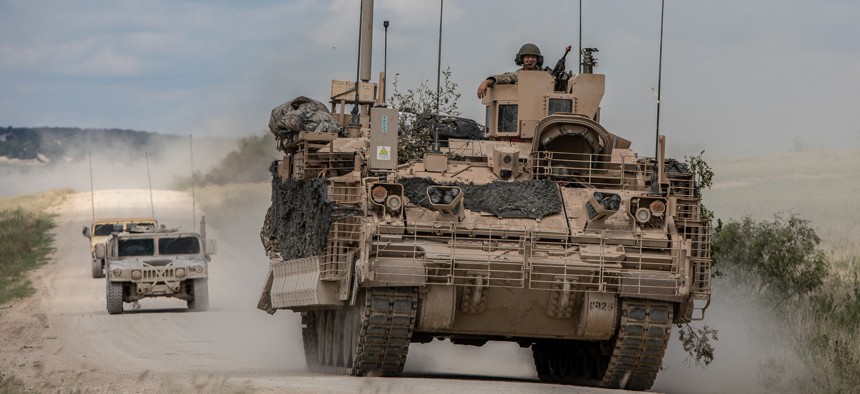Where the US Army’s Cut List and Wish List Overlap
Some programs slated for trimming in the 2022 budget proposal also appear on the service’s list of unfunded priorities.
To make space in its shrinking budget, the U.S. Army has listed 37 programs for trimming in fiscal 2022. As has become standard practice, service officials are also asking lawmakers for money for things excluded from the budget proposal sent to Congress last week. Some programs appear on both lists.
Take the Abrams tank, long the centerpiece of the land service’s armored force. A document listing the 37 programs says the Abrams effort is to be cut by about $154 million. But in their unfunded priorities list — informally known as the “wish list” — service officials ask lawmakers to add $369 million to the Abrams program to help field the third version of the tank to Army National Guard units without delays. A copy of the list was obtained by Defense One this week.
The Army’s budget is set to take a hit under the 2022 budget proposal, which would give the service $173.0 billion, down from $176.6 billion in 2021. Service leaders have been working to find places to trim for several years, including the “night court” sessions begun by then-Army Secretary Mark Esper.
An Army document distributed to media lists the 37 programs whose funding will be cut or whose schedules will be delayed to save some $1.5 billion that can be used elsewhere.

“Most of the reductions and investments are tied to programs where the funding is being used to ensure that we maintain the funding for our 31+4 modernization efforts,” Maj. Gen Paul Chamberlain, the director of the Army budget, told reporters on Tuesday.
The “31+4” efforts include 31 “signature systems that are critical to realizing Multi-Domain Operations and are aligned with these priorities,” as then-Army Secretary Mark Esper said in 2019; plus four managed by the Rapid Capabilities and Critical Technologies Office.
Those programs include the Maneuver Short-Range Air Defense, the Precision Strike Missile, and next-generation rifles.
Surprisingly, one of the largest cuts among the 37 programs will be to one of these 31 modernization priorities. The Army wants to take $577 million from its Armored Multi-Purpose Vehicle program, the replacement for the M113 vehicles that are part of armored brigade combat teams, according to a chart provided by the Army Thursday.
Others that appear on both the cut list and the wish list are Abrams, Distributed Common Ground System-Army, Husky mine detection system, and Javelin anti-tank missile. The Army wants Congress to fund about $459.2 million for these four priorities while at the same time taking a total of $274.4 million from them for other initiatives.
The Army wants to take $1.05 million from the Javelin Advanced Anti-Tank Weapon system while asking Congress to fund $15 million for its newer lightweight command launch unit for the Javelin Close Combat Missile System.
Some $70.4 million would be trimmed from the DCGS-A program, a hardware and software system that enables soldiers to pull information from intelligence sources and sensors to better understand the threats they face.
Another armored program the Army is cutting is the HERCULES recovery vehicle, capable of towing the 70-ton M1A2 Abrams tank. The Army wants to take $134.7 million from the program, according to the chart.
It’s unclear from the Army’s chart whether the service is cutting funds from newer or older parts of these programs, such as the Abrams tank, which has been around for decades and is still developing new versions of the system.
When asked why Army officials are cutting funds from these programs in the 2022 budget while also asking Congress to provide additional money, a spokesman said they are not currently commenting on “the leaked documents” — i.e., the unfunded priorities list.




